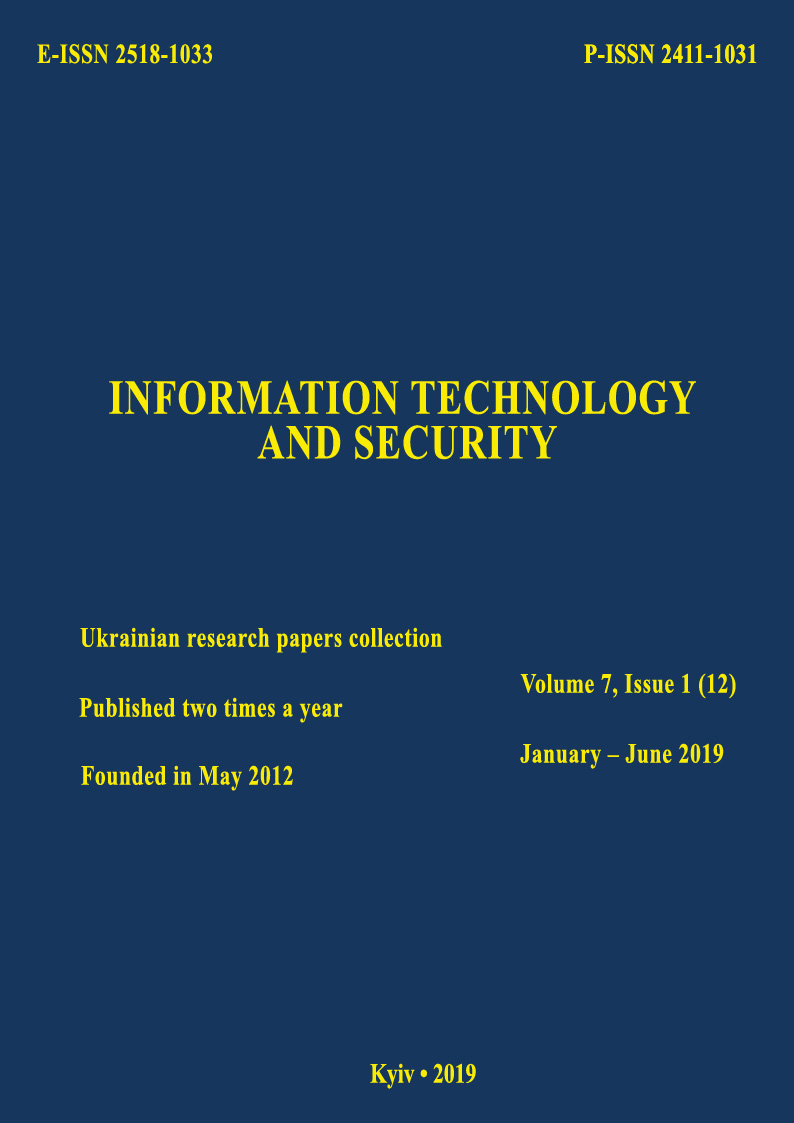Applying mobile devices in biometric user authentication systems
DOI:
https://doi.org/10.20535/2411-1031.2019.7.1.184213Keywords:
Authentication, biometric user authentication, biometric characteristic, handwritten signature, biometric authentication system, mobile deviceAbstract
The use of biometric characteristics to improve the efficiency of user authentication is considered. An identifier that uses biometric characteristics is inextricably linked to the user and is virtually impossible to use it unauthorized. According to this, it is proposed to use the dynamic biometric characteristics of users. Their advantage is that due to the dynamic component, the likelihood of their being forged by an attacker is very low. As a part of multifactor authentication system, biometrics can significantly reduce the chances of hacking user accounts by eliminating the disadvantages of classic password systems and card-based systems. The handwritten signature is used as the biometric characteristic of the user. The handwritten signature is a publicly and legally recognized biometric characteristic used for human authentication. It has a rather complex structure and high detail, all of which makes the solution of this problem mathematical methods rather complicated and requires a large computational cost. A major drawback is that handwritten signature authentication systems require the installation of additional specialized hardware. Therefore, using such systems as an ordinary authentication tool is very expensive. Nowadays the presence of mobile devices in almost all users has made it possible to form the idea of using them in authentication systems. Thanks to that a scheme for implementing a computer security system against unauthorized access based on handwritten signatures using Android-based mobile devices as signature input devices were proposed. In addition, a connection scheme between a computer and a mobile device was proposed. Its feature is that the connection between the mobile device and the computer is established by scanning the QR code displayed on the computer monitor by mobile device module. The practical value of the results obtained is confirmed by the copyright registration certificate of the software developed during the work
References
E. Anisimova, “About the verification problem using handwritten signatures”, Modern technology and technology, no. 3, 2016. [Online]. Available: http://technology.snauka.ru/ 2016/03/9715. Accessed on: Sep. 24, 2018.
A. Skorodumov, “Pros and cons of biometric identification”, Information Security, no. 6, pp. 31-33, 2018. [Online]. Available: http://lib.itsec.ru/articles2. Accessed on: Jan. 20, 2019.
I. Horniichuk, and V. Yevetskiy, “Use of keyboard handwriting in user authentication systems”, Information Technology and Security, vol. 4, iss. 1, pp. 27-33, January-June 2016.
L. Irwin, “GDPR: Things to consider when processing biometric data”, IT Governance European Blog, 2017. [Online]. Available: https://www.itgovernance.eu/blog/en/gdpr-things-to-consider-when-processing-biometric-data. Accessed on: Dec. 12, 2018.
Y. Zheludov, “Identification problems in handwritten recognition systems”, Scientific journal “Informatics”, no. 9 (32), 2018, [Online]. Available: https://cyberleninka.ru/article/n/ problemy-identifikatsii-v-sistemah-raspoznavaniya-rukopisnyh-podpisey. Accessed on: Jan. 20, 2019.
I. Anikin, and E. Anisimova, “Detection of dynamic handwritten signature based on fuzzy logic”, Bulletin of the Kazan State Energy University, no. 3 (31), pp. 48-64, 2016.
G. Kozlov, and S. Novikova, “Recognition of handwritten signatures using a wire-line neural network”, in Proc. XII International Scientific and Practical Conference. Scientific forum: technical and physical-mathematical sciences, Moscow, 2018, pp. 17-20.
V. Lipsky, “Identification of handwritten signatures using neural networks”, in Proc. 54-th scientific conference of post-graduate students, masters and students of BSUIR, Minsk, 2018, pp. 84-85.
Signature recognition, a reliable replacement for passwords. Panda Security., 2016. [Online]. Available: https://www.pandasecurity.com/mediacenter/news/signature-recognition-passwords. Accessed on: Aug 10, 2018.
I. Smirnov, and S. Borisov, “Handwriting recognition when authenticating PC users”, Succeeding in modern natural science, no. 6, pp. 99-100, 2012.
TLS 1.3 is here to stay. 2018. [Online]. Available: https://www.ssl.com/article/tls-1-3-is-here-to-stay. Accessed on: Dec 20, 2018.
I. Horniichuk, and V. Yevetskiy, “Certificate of registration of copyright for a work “Computer program for user registration for authentication by means of the system of authentication of users by their handwritten signature – MarMurAuth Registration Module”, Service of Intellectual Property of Ukraine No. 84551, Jan. 2019.
Downloads
Published
How to Cite
Issue
Section
License
Copyright (c) 2020 Collection "Information technology and security"

This work is licensed under a Creative Commons Attribution 4.0 International License.
The authors that are published in this collection, agree to the following terms:
- The authors reserve the right to authorship of their work and pass the collection right of first publication this work is licensed under the Creative Commons Attribution License, which allows others to freely distribute the published work with the obligatory reference to the authors of the original work and the first publication of the work in this collection.
- The authors have the right to conclude an agreement on exclusive distribution of the work in the form in which it was published this anthology (for example, to place the work in a digital repository institution or to publish in the structure of the monograph), provided that references to the first publication of the work in this collection.
- Policy of the journal allows and encourages the placement of authors on the Internet (for example, in storage facilities or on personal web sites) the manuscript of the work, prior to the submission of the manuscript to the editor, and during its editorial processing, as it contributes to productive scientific discussion and positive effect on the efficiency and dynamics of citations of published work (see The Effect of Open Access).

